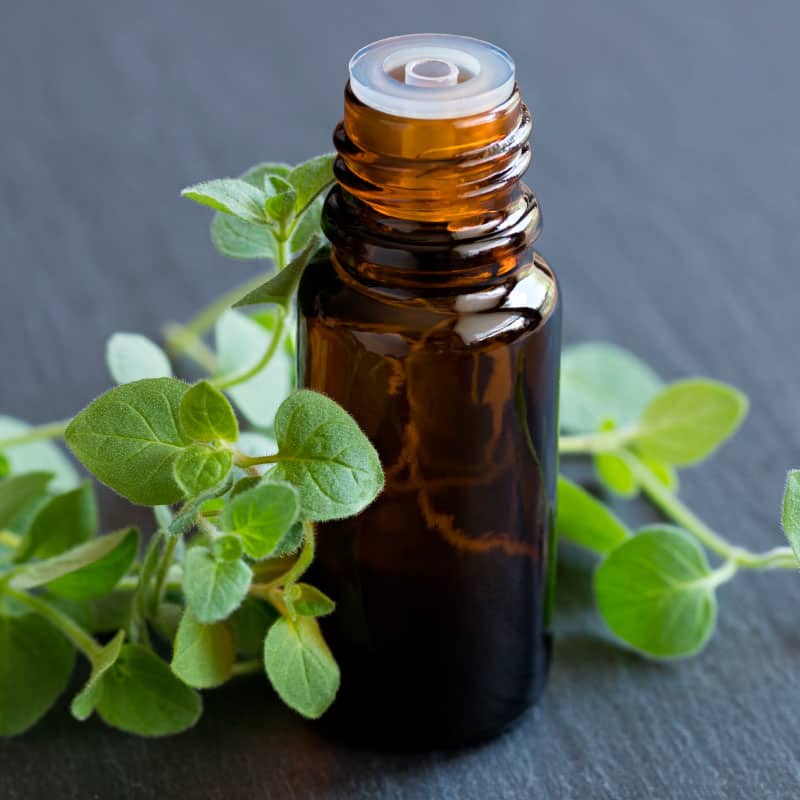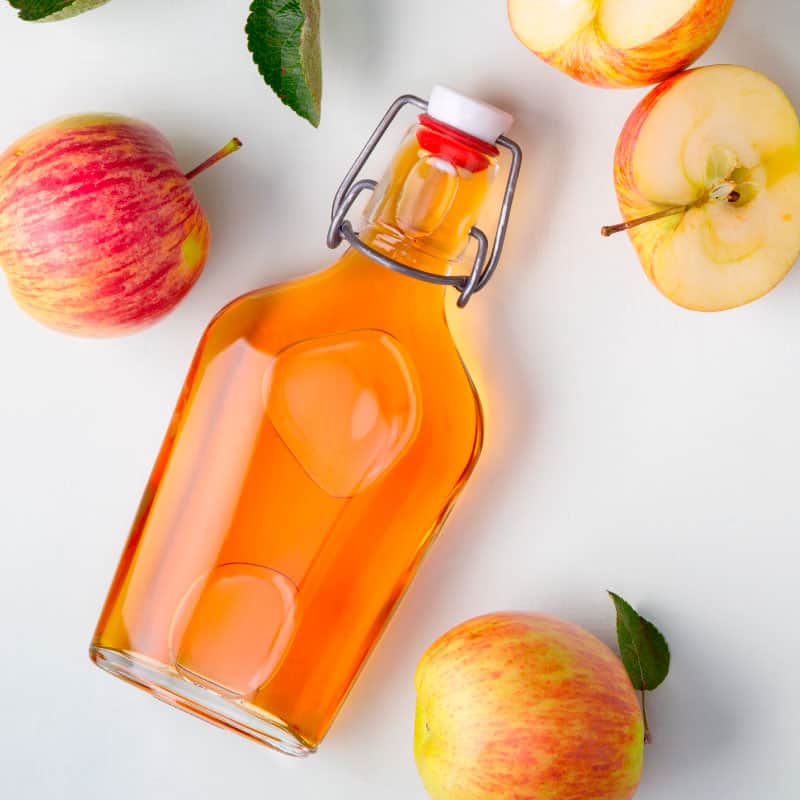This Dr. Axe content is medically reviewed or fact checked to ensure factually accurate information.
With strict editorial sourcing guidelines, we only link to academic research institutions, reputable media sites and, when research is available, medically peer-reviewed studies. Note that the numbers in parentheses (1, 2, etc.) are clickable links to these studies.
The information in our articles is NOT intended to replace a one-on-one relationship with a qualified health care professional and is not intended as medical advice.
This article is based on scientific evidence, written by experts and fact checked by our trained editorial staff. Note that the numbers in parentheses (1, 2, etc.) are clickable links to medically peer-reviewed studies.
Our team includes licensed nutritionists and dietitians, certified health education specialists, as well as certified strength and conditioning specialists, personal trainers and corrective exercise specialists. Our team aims to be not only thorough with its research, but also objective and unbiased.
The information in our articles is NOT intended to replace a one-on-one relationship with a qualified health care professional and is not intended as medical advice.
How to Get Rid of an Ingrown Toenail
March 23, 2016
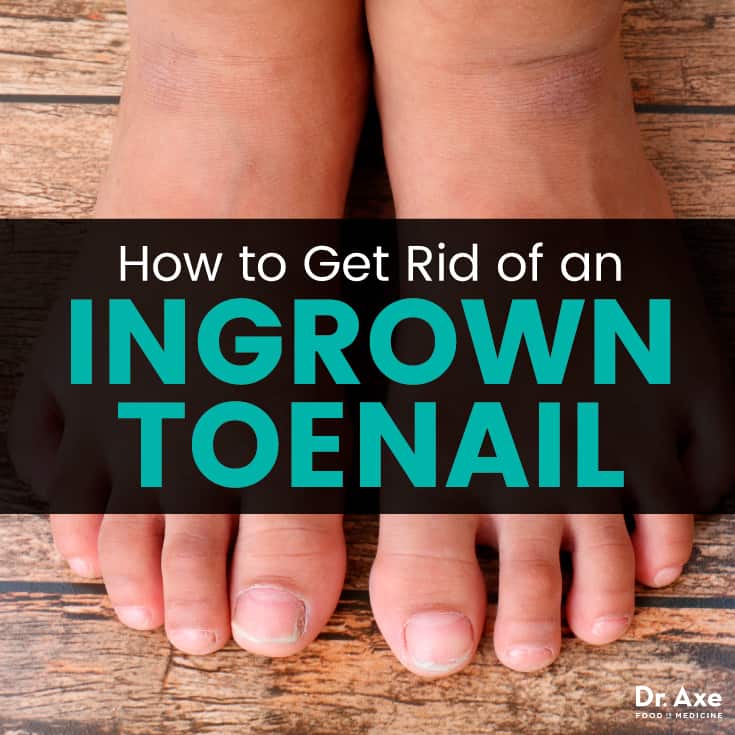
If you’ve ever had an ingrown toenail, you know the pain that it can cause. Not only that, but it’s annoying — we use our toes in some way or another as part of our usual daily movement, and this use and constant knocking seems to aggravate the nail even more. It makes the pain more noticeable and seems to last forever!
An ingrown toenail, or onychocryptosis, may occur at any age and is one of the mostly common toenail problems. It can be a painful condition that can easily become infected without proper care. While more studies need to be conducted, there are a few that suggest a slightly higher male-to-female ratio, particularly in the 14–25 age group; however, it can affect patients of any age.
There are multiple reasons why an ingrown toenail develops, including: (1)
- improper nail-cutting technique
- tight-fitting footwear
- trauma
- anatomical factors like thickening of the nail plate
- a pincer-shaped toenail
- pressure from abutting digits caused by hallux valgus or lesser toe deformities
- the presence of a subungual exostosis
- occasionally, the use of isotretinoin in the treatment of severe acne
Something that’s often forgotten is that toenail fungus can become part of the problem too. Usually, nail fungus occurs when fungus enters the nail through a small trauma, such as a cut or break in the nail. Though often a misconception, nail fungus is not caused by poor hygiene. However, if you have an ingrown toenail, you need to be conscious of keeping the area clean. (2)
Luckily, there are many natural ways to get rid of an ingrown toenail on your own without needing a trip to the doctor. Let’s take a look at some more details on ingrown toenails and how to get rid of them.
How to Get Rid of an Ingrown Toenail
What is an ingrown toenail, and what causes it? It’s a common condition in which the corner or side of a toenail grows into the soft flesh. Many anatomic and behavioral factors are thought to contribute to ingrown toenails, such as improper trimming, repetitive or inadvertent trauma, genetic predisposition, hyperhidrosis, and poor foot hygiene.
Ingrown toenails are classified into three categories: mild (stage 1), moderate (stage 2) and severe (stage 3). Mild cases are characterized by nail-fold swelling, erythema, edema and pain with pressure. Moderate cases are associated with increased swelling, drainage, infection and ulceration of the nail fold. The most severe cases of ingrown toenail exhibit chronic inflammation and granulation, as well as marked nail-fold hypertrophy.
Regardless, the result is pain, redness, swelling and, sometimes, an infection. Ingrown nails usually affect the big toe, though other toes can also be affected. Most often, ingrown toenails can be self-treated. However, if the pain is severe or spreading, you may need to check in with your doctor to relieve your discomfort and help you avoid further complications.
To understand how this condition happens, first you should know that the toenail consists of various parts, including:
- the nail plate (which is the part you can see)
- the nail bed (the skin the nail plate protects)
- the cuticle (the skin that rims the base of the nail)
- the nail folds (the three-sided frame of the nail)
- the lunula (that half-moon, whitish part at the bottom of the nail)
- the nail matrix (the hidden nail portion underneath the cuticle)
How can you be sure you have an ingrown toenail? If you have any of the following symptoms, chances are you do:
- Pain and tenderness in your toe along one or both sides of the nail
- Redness around your toenail
- Swelling of your toe around the nail
- Infection of the nail folds around your toenail
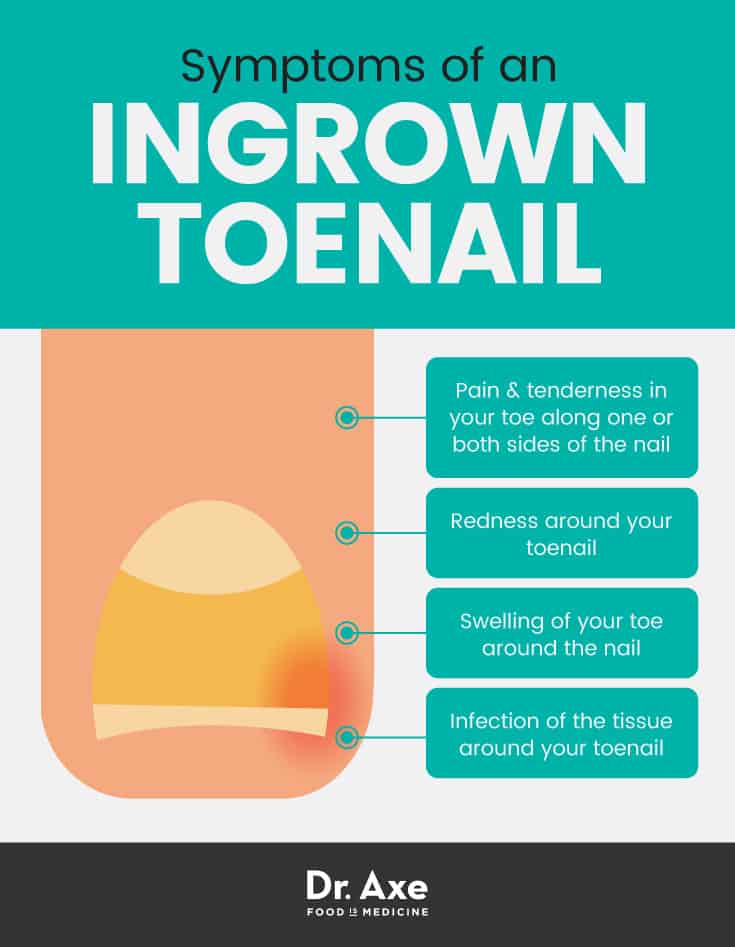
The good news is there are natural ways to treat the an ingrown toenail. Though many resort to surgery if in stages 2 or 3, that is usually not necessary if the nail is in stage 1, especially if you take care of the situation as soon as you notice it. (3) Here’s how:
1. Soak or Wash the Foot
Soaking the foot in warm, soapy water can be very beneficial in helping keep the area clean and free of bacteria. Soak the foot in warm water three to four times per day. You can add Epsom salt to the water to soften the skin of the affected area, which could make it easier to draw out the toenail from the skin.
2. Wash with Castile Soap
If soaking doesn’t work well with your schedule, you can try washing the foot and offending nail twice a day with soap and water. You may want to consider Castile soap due to its natural and pure ingredients. Make sure to keep the foot clean and dry.
3. Apple Cider Vinegar Wash
Apple cider vinegar can help as a natural treatment for an ingrown toenail. You can try adding a quarter cup of vinegar to warm water for a foot soak or direct application of apple cider vinegar that has been diluted with purified water, which conditions ingrown nails to fight bacteria that may try to form.
While applying diluted apple cider vinegar to a wound may stave off infection, it may not cure an existing bacterial infection. However, it has antibacterial characteristics that can help keep the area clean as it heals.
4. Dental Floss Under the Nail
Placing cotton wisps or dental floss under the ingrown nail border can help by shifting the nail to grow in the correct direction instead of down into the skin. Try to lift up the corner of the nail that’s digging into the skin. Take a very small piece of cotton or gauze and roll it between the fingers to form a small roll or wick. Place it between the nail plate and the nail folds.
For a gentler method, use the dental floss, but make sure it’s not a flavored version as that could cause a burning sensation. The idea is to keep the nail elevated long enough to allow it to grow out and away from the skin. This is uncomfortable but effective.
Another helpful step you can take after every soaking is to try to push the roll a little farther in. Make sure to change the roll out every day. It may take one to two weeks for the nail to grow out, so be patient. In some cases, you may need to carefully cut the nail to get underneath it. Below I have included step-by-step instructions on how to cut the nail.
5. Avoid High Heels and Tight Shoes
I know many women enjoy the look of high heels, but if you want the ingrown toenail to remedy quickly, you should avoid these shoes. They can cause more pressure to be placed in the affected area, and that’s likely to cause a big delay in healing as well as pain. Tight-fitting shoes of any kind can cause this problem. Sandals can be helpful, allowing the nail the freedom to heal correctly.
6. Use Essential Oils to Help Reduce Inflammation and Pain
You can create your very own essential oil blend by combining melaleuca, (tea tree oil), cyprus, clove, lavender and rosemary with a carrier oil, such as coconut oil. Blend well, then gently massage onto the affected area. This helps you avoid synthetic medications by providing natural pain relief for the ingrown toenail and ultimately giving the area a healthier environment with which to heal. I have provided an ingrown toenail ointment recipe below using essential oils that may work well for you.
How to Cut an Ingrown Toenail
Cutting an ingrown toenail can be difficult, which is why I recommend that you’re very careful and have some help if you choose to do it at home. Here’s a step-by-step guide:
- First, soak your feet in warm water mixed with either Epsom salt or Castile soap for about 20 minutes to help soften the toenail and skin and reduce any swelling.
- Next, using clean fingers, push back the swollen skin carefully from the nail border. This will likely be uncomfortable. Don’t force it back more than the swollen skin allows.
- Now, you need to cut the nail straight across. Start with the edges of the toenail, cutting the nail from the sides, not from the middle.
- Place a small piece of cotton between the ingrown nail and skin. This helps stop the ingrown toenail from coming back, allowing it to grow correctly.
- Apply the ointment in the recipe below to the affected area and bandage it carefully.
- To help with healing and to stop future in-growing, avoid wearing socks and shoes while at home. Wear flip-flops or a shoe that avoids dirt but allows air to circulate.
- It’s important to prevent infection by changing the cotton daily, maybe even twice a day.
Homemade Ingrown Toenail Ointment Recipe
You can make your very own ointment to help heal an ingrown toenail. Essential oils can help relieve pain and prevent infection. By putting this ointment directly on your toe, you can find some much-needed relief and and faster healing.
INGREDIENTS:
- 5 drops eucalyptus oil
- 5 drops tea tree oil
- 1 drop oregano oil
- 5 drops lavender oil
- 2 drops peppermint oil
- 2 ounces aloe vera gel
- 2 ounces coconut oil
DIRECTIONS:
- Place all ingredients in a small glass jar with a tight-fitting lid.
- Using a small spoon, stir until well-blended.
- After careful cleansing and rinsing of the toe, apply the ointment on the area.
- Allow it to air dry, if possible, by wearing flip-flops. If not, carefully and loosely bandage the toe, but make sure to wear loose-fitting shoes.
- Redress the area two to three times per day. Make sure to wash the hands after and avoid the eyes, especially when using oregano oil. Oregano is a natural antibiotic but can be very strong, giving a burning sensation. It’s important to use these oils as prescribed, with a carrier oil such as coconut oil.
Common Causes of an Ingrown Toenail
Some of the most common causes of an ingrown toenail include: (4)
- Wearing shoes that crowd the toenails, such as heels or any shoes that are too tight (this is the No. 1 risk factor for ingrown toenails, according to the American Academy of Orthopaedic Surgeons (AAOS))
- Cutting toenails too short or not straight across
- Injuring the toenail
- Having unusually curved toenails
- Toe deformities
- Subungual exostosis (outgrowth of bone from the tip of the toe)
- Use of isotretinoin in the treatment of severe acne
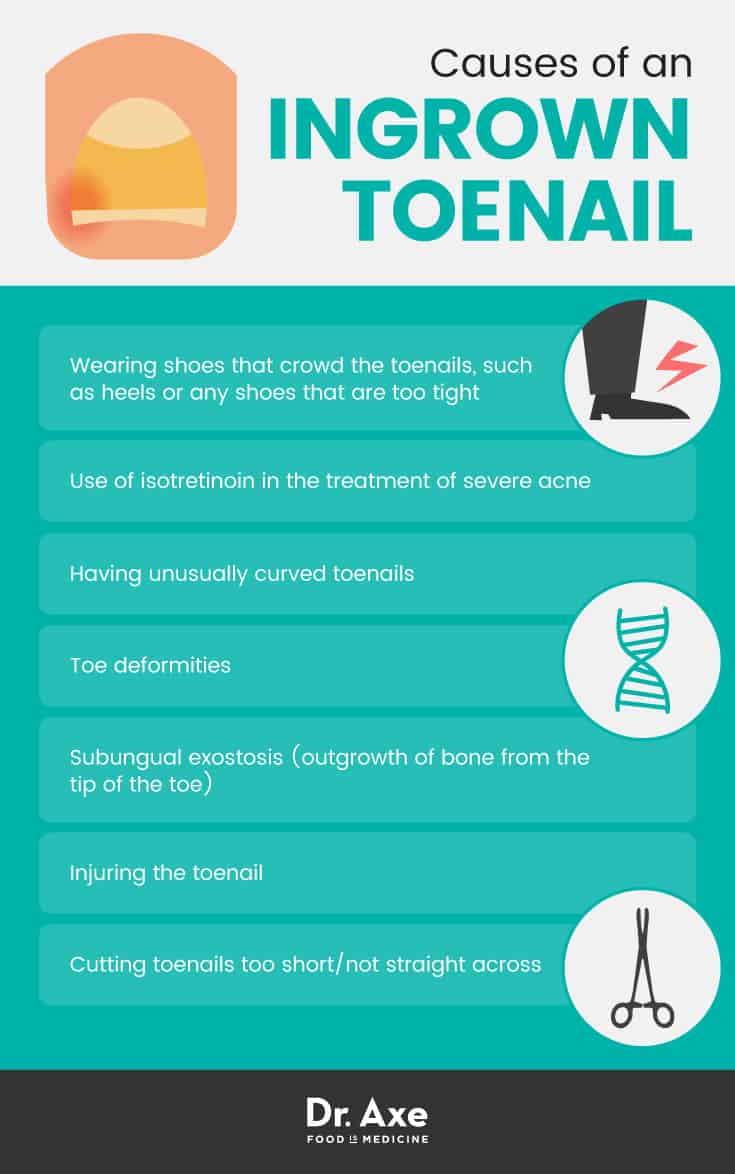
There are many risk factors involved in the development of ingrown nails, such as anatomic and behavioral mechanisms. Some experts suggest that wider nail folds and thinner, flatter nails may increase the risk of ingrown toenails. A case-control study with 46 patients found no difference in the anatomic shape of toenails in patients with and without ingrown toenails. (5)
Repetitive trauma, such as running, kicking or inadvertent trauma like stubbing the toe, may be other ingrown toenail causes. Without any strict evidence basis, it’s thought that a genetic predisposition and family history, hyperhidrosis, and poor foot hygiene increase the likelihood of ingrown toenails. Diabetes, obesity, thyroid, cardiac and renal disorders that may predispose to lower extremity edema can also increase the likelihood.
In adolescence, feet perspire more often, causing the skin and nails to become soft, resulting in easy splitting. This produces nail spicules (sharp points that of the nail) that can pierce the lateral skin. In older persons, spicule formation can become a chronic problem caused by their reduced ability to care for their nails, secondary to reduced mobility or impaired vision. In addition, the natural aging process causes toenails to thicken, making them more difficult to cut and more inclined to exert pressure on the lateral skin at the sides of the nail plate, often becoming ingrown, painful and infected.
According to a 2005 Cochrane Review, rates of regrowth after treatment were 34 percent to 50 percent. In 1959, Vandenbos and Bowers noted that patients who developed this nail problem tend to have an excessive amount of tissue at the sides of the affected nail. They theorized that weight-bearing caused the tissue to bulge over the sides of the nail, which can result in the growth of the toenail into the skin. (6)
I want to note that an ingrown fingernail is similar in terms of how it happens. The usual causes of ingrown fingernails are due to improper trimming of the nail, an injury and even nail biting. And, like the toenail, sometimes the natural shape or thickness of the nail can make it more susceptible to becoming ingrown. (7)
Whatever the cause, and regardless as to whether it’s an ingrown toenail or ingrown fingernail, it can be incredibly annoying to excruciatingly painful. And if left untreated, it can become infected.
By avoiding or minimizing some of these risk factors, it may be possible to prevent ingrown toenails.
Medical Treatment of Ingrown Toenails
Once your ingrown toenail has progressed past the first stage, you may need to seek medical help. There are various surgical treatments of ingrown toenails your podiatrist may recommend. All of these are standard, according to the American Academy of Orthopaedic Surgeons (AAOS).
Wedge Resection: This involves the partial removal of the nail or a portion of it, after numbing your toe with a local anesthetic and draining any ingrown toenail infection. Your doctor can perform this procedure in the office and the recovery time is anywhere between two weeks to two months, depending on the size of the nail portion removed.
Matrixectomy: The matrixectomy procedure is also referred to as permanent or full nail avulsion. Unlike typical avulsions, which aren’t often practiced anymore (they often result in further issues), a matrixectomy happens when the physician removes the entire nail from your nail bed and then covers the nail matrix (the tissue beneath your nail) with a chemical that stops it from ever growing back.
Vandenbos Procedure: The Vandenbos procedure has been around since the late 1950s and involves removal of the skin directly underneath and on either side of the ingrown toenail. Recovery is longer with this procedure, but this is also the only procedure in which a doctor does not need to prescribe antibiotics for prevention of infections. It also seems to be the procedure most likely to prevent recurrences of ingrown nails.
Risks, Complications and Things You Should Know About Ingrown Toenails
It’s also important to note that if you have diabetes or another condition that causes poor blood flow to your feet, you’re at greater risk of complications of ingrown toenails. (8) That’s just another reason to treat your diabetes.
Left untreated or undetected, an ingrown toenail can infect the underlying bone and lead to a serious bone infection. Complications can be especially severe if you have diabetes, which can cause poor blood flow and damage nerves in your feet. So a minor foot injury — a cut, scrape, corn, callus or ingrown toenail — may not heal properly and become infected.
A difficult-to-heal open sore (foot ulcer) may require surgery to prevent the decay and death of tissue (gangrene). Gangrene results from an interruption in blood flow to an area of your body. (9)
Other Diseases Affecting the Toenails
While ingrown toenails are the most common foot ailment, there are various foot diseases that cause nail problems and often have to be ruled out before diagnosing ingrown toenails.
Lichen Planus: Lichen planus, or “LP,” is a form of dermatitis that causes skin lesions on the foot (and sometimes other regions of the body). In about 10 percent of cases, toenails are affected, causing ridging and grooving, splitting, nail thinning and eventually, nail loss. (10)
Alopecia Areata: While most people think of alopecia in terms of hair loss, the impact it has on nails is sometimes the first sign of the disease. Within this disease, offending nails become pitted or split, frequently causing a rough appearance and white spots. (11)
Onychomycosis: This fungal infection of the fingernails or toenails might involve any part of the nail (matrix, bed or plate). Onychomycosis can cause pain/discomfort and even disfigurement, and the progression of the disease may result in problems with standing, walking and exercising. The foot complications involved with onychomycosis are also frequently responsible for causing social and professional limitations to those afflicted. (12)
Final Thoughts on Ingrown Toenails
- An ingrown toenail, or onychocryptosis, may occur at any age and is one of the most common toenail problems. It can be a painful condition that can become infected if not properly cared for. Ingrown toenails usually affect the big toe, though other toes can also be affected.
- Ingrown toenails are classified into three categories: mild (stage 1), moderate (stage 2) and severe (stage 3). Mild cases are characterized by nail-fold swelling, erythema, edema and pain with pressure. Moderate cases are associated with increased swelling, drainage, infection and ulceration of the nail fold. The most severe cases of ingrown toenail exhibit chronic inflammation and granulation, as well as marked nail-fold hypertrophy.
- Some of the most common causes of an ingrown toenail include wearing shoes that crowd the toenails, such as heels or any shoes that are too tight, cutting toenails too short or not straight across, injuring the toenail, having unusually curved toenails, toe deformities, subungual exostosis (outgrowth of bone from the tip of the toe), and use of isotretinoin in the treatment of severe acne.
- Ingrown toenail symptoms include pain and tenderness in your toe along one or both sides of the nail, redness around your toenail, swelling of your toe around the nail, and infection of the tissue around your toenail.
- To get rid of an ingrown toenail at home, you can soak or wash the foot, wash with Castile soap, try an apple cider vinegar wash, use dental floss under the nail, avoid high heels and tight shoes, and use essentials oils to help reduce inflammation and pain.


